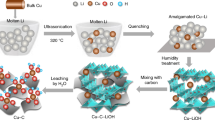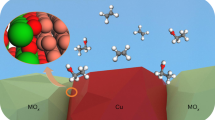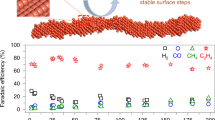Abstract
The discovery of materials for the electrochemical transformation of carbon dioxide into liquid fuels has the potential to impact large-scale storage of renewable energies and reduce carbon emissions. Here, we report the discovery of an electrocatalyst composed of gold nanoparticles on a polycrystalline copper foil (Au/Cu) that is highly active for CO2 reduction to alcohols. At low overpotentials, the Au/Cu electrocatalyst is over 100 times more selective for the formation of products containing C–C bonds versus methane or methanol, largely favouring the generation of alcohols over hydrocarbons. A combination of electrochemical testing and transport modelling supports the hypothesis that CO2 reduction on gold generates a high CO concentration on nearby copper, where CO is further reduced to alcohols such as ethanol and n-propanol under locally alkaline conditions. The bimetallic Au/Cu electrocatalyst exhibits synergistic activity and selectivity superior to gold, copper or AuCu alloys, and opens new possibilities for the development of CO2 reduction electrodes exploiting tandem catalysis mechanisms.
This is a preview of subscription content, access via your institution
Access options
Access Nature and 54 other Nature Portfolio journals
Get Nature+, our best-value online-access subscription
$29.99 / 30 days
cancel any time
Subscribe to this journal
Receive 12 digital issues and online access to articles
$119.00 per year
only $9.92 per issue
Buy this article
- Purchase on Springer Link
- Instant access to full article PDF
Prices may be subject to local taxes which are calculated during checkout





Similar content being viewed by others
Data availability
The data that support the results and other findings of this study are available from the corresponding authors upon reasonable request.
References
Whipple, D. & Kenis, P. Prospects of CO2 utilization via direct heterogeneous electrochemical reduction. J. Phys. Chem. Lett. 1, 3451–3458 (2010).
Arakawa, H. et al. Catalysis research of relevance to carbon management: progress, challenges, and opportunities. Chem. Rev. 101, 953–996 (2001).
Qiao, J., Liu, Y., Hong, F. & Zhang, J. A review of catalysts for the electroreduction of carbon dioxide to produce low-carbon fuels. Chem. Soc. Rev. 43, 631–675 (2014).
Hori, Y., Vayenas, C., White, R. & Gamboa-Aldeco, M. Electrochemical CO2 reduction on metal electrodes. Mod. Aspects Electroc. 42, 89–189 (2008).
Kuhl, K. et al. Electrocatalytic conversion of carbon dioxide to methane and methanol on transition metal surfaces. J. Am. Chem. Soc. 136, 14107–14113 (2014).
Kuhl, K. P., Cave, E. R., Abram, D. N. & Jaramillo, T. F. New insights into the electrochemical reduction of carbon dioxide on metallic copper surfaces. Energy Environ. Sci. 5, 7050–7059 (2012).
Hatsukade, T., Kuhl, K., Cave, E., Abram, D. & Jaramillo, T. Insights into the electrocatalytic reduction of CO2 on metallic silver surfaces. Phys. Chem. Chem. Phys. 16, 13814–13819 (2014).
Torelli, D. et al. Nickel–gallium-catalyzed electrochemical reduction of CO2 to highly reduced products at low overpotentials. ACS Catal. 6, 2100–2104 (2016).
Hori, Y. & Murata, A. Electrochemical evidence of intermediate formation of adsorbed CO in cathodic reduction of CO2 at a nickel electrode. Electrochim. Acta 35, 1777–1780 (1990).
Song, Y. et al. High-selectivity electrochemical conversion of CO2 to ethanol using a copper nanoparticle/N-doped graphene electrode. ChemistrySelect 1, 6055–6061 (2016).
Hoang, T., Ma, S., Gold, J., Kenis, P. & Gewirth, A. Nanoporous copper films by additive-controlled electrodeposition: CO2 reduction catalysis. ACS Catal. 7, 3313–3321 (2017).
Hoang, T. T. H. et al. Nanoporous copper–silver alloys by additive-controlled electrodeposition for the selective electroreduction of CO2 to ethylene and ethanol. J. Am. Chem. Soc. 140, 5791–5797 (2018).
Li, C., Ciston, J. & Kanan, M. Electroreduction of carbon monoxide to liquid fuel on oxide-derived nanocrystalline copper. Nature 508, 504–507 (2014).
Verdaguer-Casadevall, A. et al. Probing the active surface sites for CO reduction on oxide-derived copper electrocatalysts. J. Am. Chem. Soc. 137, 9808–9811 (2015).
Ren, D., Ang, B. & Yeo, B. Tuning the selectivity of carbon dioxide electroreduction toward ethanol on oxide-derived CuxZn catalysts. ACS Catal. 6, 8239–8247 (2016).
Clark, E. L., Hahn, C., Jaramillo, T. F. & Bell, A. T. Electrochemical CO2 reduction over compressively strained CuAg surface alloys with enhanced multi-carbon oxygenate selectivity. J. Am. Chem. Soc. 139, 15848–15857 (2017).
Sun, H., Yu, M., Wang, G., Sun, X. & Lian, J. Temperature-dependent morphology evolution and surface plasmon absorption of ultrathin gold island films. J. Phys. Chem. C 116, 9000–9008 (2012).
Guisbiers, G. et al. Gold-copper nano-alloy, "Tumbaga", in the era of nano: phase diagram and segregation. Nano Lett. 14, 6718–6726 (2014).
Lum, Y. & Ager Joel, W. Stability of residual oxides in oxide‐derived copper catalysts for electrochemical CO2 reduction investigated with 18O labeling. Angew. Chem. Int. Ed. 57, 551–554 (2017).
Ikemiya, N., Kubo, T. & Hara, S. In-situ AFM observations of oxide film formation on Cu(111) and Cu(100) surfaces under aqueous alkaline-solutions. Surf. Sci. 323, 81–90 (1995).
Mistry, H. et al. Highly selective plasma-activated copper catalysts for carbon dioxide reduction to ethylene. Nat. Commun. 7, 12123 (2016).
Eilert, A. et al. Subsurface oxygen in oxide-derived copper electrocatalysts for carbon dioxide reduction. J. Phys. Chem. Lett. 8, 285–290 (2017).
Manthiram, K., Surendranath, Y. & Alivisatos, A. Dendritic assembly of gold nanoparticles during fuel-forming electrocatalysis. J. Am. Chem. Soc. 136, 7237–7240 (2014).
Wang, J. et al. Formation, migration, and reactivity of Au–CO complexes on gold surfaces. J. Am. Chem. Soc. 138, 1518–1526 (2016).
Kim, Y., Baricuatro, J., Javier, A., Gregoire, J. & Soriaga, M. The evolution of the polycrystalline copper surface, first to Cu(111) and then to Cu(100), at a fixed CO2RR potential: a study by operand EC-STM. Langmuir 30, 15053–15056 (2014).
Papanicolaou, N. & Evangelakis, G. in Surface Diffusion (ed. Tringides, M. C.) 75–81 (NATO ASI Series B 360, Springer, Boston, MA, 1997).
Balerna, A. et al. Extended X-ray absorption fine-structure and near-edge-structure studies on evaporated small clusters of Au. Phys. Rev. B 31, 5058–5065 (1985).
Cave, E. R. et al. Electrochemical CO2 reduction on Au surfaces: mechanistic aspects regarding the formation of major and minor products. Phys. Chem. Chem. Phys. 19, 15856–15863 (2017).
Benck, J., Hellstern, T., Kibsgaard, J., Chakthranont, P. & Jaramillo, T. Catalyzing the hydrogen evolution reaction (HER) with molybdenum sulfide nanomaterials. ACS Catal. 4, 3957–3971 (2014).
Jia, F., Yu, X. & Zhang, L. Enhanced selectivity for the electrochemical reduction of CO2 to alcohols in aqueous solution with nanostructured Cu–Au alloy as catalyst. J. Power Sources 252, 85–89 (2014).
Andrews, E. et al. Electrochemical reduction of CO2 at Cu nanocluster / (1010) ZnO electrodes. J. Electrochem. Soc. 160, H841–H846 (2013).
Peterson, A. & Norskov, J. Activity descriptors for CO2 electroreduction to methane on transition-metal catalysts. J. Phys. Chem. Lett. 3, 251–258 (2012).
Liu, X. et al. Understanding trends in electrochemical carbon dioxide reduction rates. Nat. Commun. 8, 15438 (2017).
Kim, D. et al. Electrochemical activation of CO2 through atomic ordering transformations of AuCu nanoparticles. J. Am. Chem. Soc. 139, 8329–8336 (2017).
Kim, D., Resasco, J., Yu, Y., Asiri, A. & Yang, P. Synergistic geometric and electronic effects for electrochemical reduction of carbon dioxide using gold–copper bimetallic nanoparticles. Nat. Commun. 5, 5948 (2014).
Mistry, H., Reske, R., Strasser, P. & Roldan Cuenya, B. Size-dependent reactivity of gold–copper bimetallic nanoparticles during CO2 electroreduction. Catal. Today 288, 30–36 (2017).
Monzo, J. et al. Enhanced electrocatalytic activity of Au@Cu core@shell nanoparticles towards CO2 reduction. J. Mater. Chem. A 3, 23690–23698 (2015).
Gupta, N., Gattrell, M. & MacDougall, B. Calculation for the cathode surface concentrations in the electrochemical reduction of CO2 in KHCO3 solutions. J. Appl. Electrochem. 36, 161–172 (2006).
Goodpaster, J., Bell, A. & Head-Gordon, M. Identification of possible pathways for C–C bond formation during electrochemical reduction of CO2: new theoretical insights from an improved electrochemical model. J. Phys. Chem. Lett. 7, 1471–1477 (2016).
Montoya, J., Peterson, A. & Norskov, J. Insights into CC coupling in CO2 electroreduction on copper electrodes. ChemCatChem 5, 737–742 (2013).
Perez-Gallent, E., Figueiredo, M., Calle-Vallejo, F. & Koper, M. Spectroscopic observation of a hydrogenated CO dimer intermediate during CO reduction on Cu(100) electrodes. Angew. Chem. Int. Ed. 56, 3621–3624 (2017).
Hahn, C. et al. Engineering Cu surfaces for the electrocatalytic conversion of CO2: controlling selectivity toward oxygenates and hydrocarbons. Proc. Natl Acad. Sci. USA 114, 5918–5923 (2017).
Akhade, S. et al. Poisoning effect of adsorbed CO during CO2 electroreduction on late transition metals. Phys. Chem. Chem. Phys. 16, 20429–20435 (2014).
Hori, Y., Murata, A., Ito, S.-y, Yoshinami, Y. & Koga, O. Nickel and iron modified copper electrode for electroreduction of CO2 by in-situ electrodeposition. Chem. Lett. 18, 1567–1570 (1989).
He, J., Johnson Noah, J. J., Huang, A. & Berlinguette Curtis, P. Electrocatalytic alloys for CO2 reduction. ChemSusChem 11, 48–57 (2017).
Watanabe, M., Shibata, M., Kato, A., Azuma, M. & Sakata, T. Design of alloy electrocatalysts for CO2 reduction: III. The selective and reversible reduction of CO2 on Cu alloy electrodes. J. Electrochem. Soc. 138, 3382–3389 (1991).
Chen, C. S., Wan, J. H. & Yeo, B. S. Electrochemical reduction of carbon dioxide to ethane using nanostructured Cu2O-derived copper catalyst and palladium(II) chloride. J. Phys. Chem. C 119, 26875–26882 (2015).
Varela, A. S. et al. CO2 electroreduction on well-defined bimetallic surfaces: Cu overlayers on Pt(111) and Pt(211). J. Phys. Chem. C 117, 20500–20508 (2013).
Verma, S., Lu, X., Ma, S., Masel, R. & Kenis, P. The effect of electrolyte composition on the electroreduction of CO2 to CO on Ag based gas diffusion electrodes. Phys. Chem. Chem. Phys. 18, 7075–7084 (2016).
Resasco, J., Lum, Y., Clark, E., Zeledon, J. & Bell, A. Effects of anion identity and concentration on electrochemical reduction of CO2. ChemElectroChem 5, 1064–1072 (2018).
Resasco, J. et al. Promoter effects of alkali metal cations on the electrochemical reduction of carbon dioxide. J. Am. Chem. Soc. 139, 11277–11287 (2017).
Hori, Y., Takahashi, R., Yoshinami, Y. & Murata, A. Electrochemical reduction of CO at a copper electrode. J. Phys. Chem. B 101, 7075–7081 (1997).
Varela, A. et al. pH effects on the selectivity of the electrocatalytic CO2 reduction on graphene-embedded Fe–N–C motifs: bridging concepts between molecular homogeneous and solid-state heterogeneous catalysis. ACS Energy Lett. 3, 812–817 (2018).
Schouten, K., Gallent, E. & Koper, M. The influence of pH on the reduction of CO and CO2 to hydrocarbons on copper electrodes. J. Electroanal. Chem. 716, 53–57 (2014).
Billy, J. & Co, A. Experimental parameters influencing hydrocarbon selectivity during the electrochemical conversion of CO2. ACS Catal. 7, 8467–8479 (2017).
Acknowledgements
This material is based on work performed by the Joint Center for Artificial Photosynthesis, a Department of Energy (DOE) Energy Innovation Hub, as follows: the development of electrochemical testing was supported through the Office of Science of the US DOE under award number DE-SC0004993; the development of the gold on copper morphology and the physical characterization of catalysts were supported by the National Science Foundation under grant number 1066515 and by the Global Climate Energy Project at Stanford University. The work of C.G.M.-G. was supported by the Swiss National Science Foundation (grant number P2ELP2_168600). E.R.C. acknowledges support from the National Science Foundation Graduate Research Fellowship under grant number DGE-1147470 and from a Ford Foundation Fellowship. L.W. thanks the Knut and Alice Wallenberg Foundation for financial support. We thank the Stanford NMR Facility and the Stanford Nano Shared Facilities for use of their shared facilities. In particular, we thank T. Carver from the Flexible Cleanroom at the Stanford Nano Shared Facilities for his role in depositing the gold nanoparticles and A. Vailionis at the Stanford Nanocharacterization Laboratory for assistance with the XRD measurements.
Author information
Authors and Affiliations
Contributions
C.G.M.-G. and E.R.C. synthesized the Au/Cu catalyst and performed the electrochemistry experiments. J.T.F., K.P.K., D.N.A. and T.H. conducted the electrochemistry experiments. L.W. designed and guided the electrochemistry experiments using carbon monoxide. S.A.N. compared the state-of-the-art bimetallic copper catalysts. C.G.M.-G., E.R.C. and L.W. carried out the SEM and XPS experiments. A.J. and N.C.J. performed the TEM experiments. C.G.M.-G. developed the mass transfer mathematical model. All authors analysed the data. T.F.J. and C.H. conceived the project and supervised the research work. C.G.M.-G., E.R.C., C.H. and T.F.J. wrote the manuscript with input from the other authors.
Corresponding authors
Ethics declarations
Competing interests
The authors declare no competing interests.
Additional information
Publisher’s note: Springer Nature remains neutral with regard to jurisdictional claims in published maps and institutional affiliations.
Supplementary information
Supplementary Information
Supplementary Tables 1–3, Supplementary Figures 1–20, Supplementary Notes 1–3 and Supplementary References
Rights and permissions
About this article
Cite this article
Morales-Guio, C.G., Cave, E.R., Nitopi, S.A. et al. Improved CO2 reduction activity towards C2+ alcohols on a tandem gold on copper electrocatalyst. Nat Catal 1, 764–771 (2018). https://doi.org/10.1038/s41929-018-0139-9
Received:
Accepted:
Published:
Issue Date:
DOI: https://doi.org/10.1038/s41929-018-0139-9
This article is cited by
-
Co-catalytic metal–support interactions in single-atom electrocatalysts
Nature Reviews Materials (2024)
-
Tandem reactors and reactions for CO2 conversion
Nature Chemical Engineering (2024)
-
Pure-water-fed, electrocatalytic CO2 reduction to ethylene beyond 1,000 h stability at 10 A
Nature Energy (2024)
-
Advances in bio-inspired electrocatalysts for clean energy future
Nano Research (2024)
-
Cu-Based Materials for Enhanced C2+ Product Selectivity in Photo-/Electro-Catalytic CO2 Reduction: Challenges and Prospects
Nano-Micro Letters (2024)



